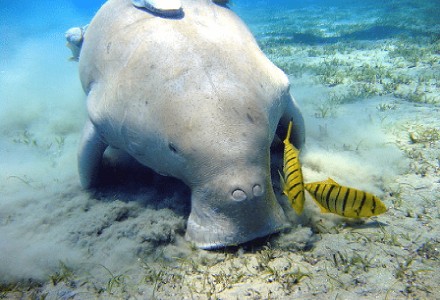
Photographer: Lord Mountbatten
CC License: https://bit.ly/37t9xca
Dugong Facts
- Firstly, the remarkable Dugong is a very large species of marine mammal. Furthermore, it is one of only four surviving species of the order Sirenia.
- In fact, it is also the only sirenian in its native range, which includes the waters of at least 40 countries
- The Dugong is also the only strictly marine herbivorous mammal. Quite sadly, a related species, the Steller’s Sea Cow, was hunted to extinction in the 18th century.
- Finally, due to a combination of factors, the IUCN currently lists the Dugong as Highly Vulnerable.
Related Articles
Leopard Seal Ringed Seal Steller Sea Lion
Public Domain Image
Dugong Physical Description
Despite its quite impressive appearance, the Dugong remains a comparatively small marine mammal. This is due to its average length of only 9.8 ft (3 m), and a weight rarely exceeding 926 lb (420 kg).
Further, the Dugong does exhibit a moderate degree of sexual dimorphism. Because of this, females generally attain a somewhat larger size than males. In fact, the largest ever recorded was a female that reached 13.3 ft (4.06 m).
In addition, the body shape appears roughly cylindrical, and tapers at each end. Also, the skin in adults usually appears a brownish-gray, in comparison with the cream color at birth.
- Kingdom: Animalia
- Phylum: Chordata
- Class: Mammalia
- Order: Sirenia
- Family: Dugongidae
- Genus: Dugong
- Species: D. dugon
Dugong Distribution, Habitat, and Ecology
Most notably, the Dugong principally resides in warm coastal ocean waters. It ranges from the western Pacific Ocean to the eastern coast of Africa and inhabits the warm waters along the coastline.
But, large numbers will congregate in wide, shallow protected bays. Furthermore, it also appears in mangrove channels, and the leeward sides of large islands. This is due to the fact that all those areas offer the common presence of seagrass beds.
Further, different habitats play a role in different activities. For example, shallow waters are favorite sites for birthing as it minimizes the risk of predation. Also, deeper waters may provide a thermal refuge from cooler waters closer to the shore during winter.
The Dugong is commonly called a sea cow because its diet consists principally of sea-grass. When feeding, it typically ingests the entire plant, including the roots.
It willalso consume algae when seagrass is scarce. Finally, although the animal is indeed primarily herbivorous, it will occasionally eat small invertebrates.
Species Sharing Its Range
Blue Shark Sea Spider Sperm Whale
Check out our other articles on 7 Unbelievable Amphibians, Northern Bald Ibis, Playa de Gulpiyuri, Scrub Morning Glory, Pinta Island Tortoise, Stinging Nettle Caterpillar

